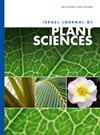海盐胁迫对大奈恩香蕉形态和生化指标的影响
IF 0.9
4区 生物学
Q4 PLANT SCIENCES
引用次数: 0
摘要
香蕉在海滨地区大量种植,这些地区极易出现海平面上升或海水与地下水混合的情况。本研究旨在探讨海盐胁迫对香蕉幼苗生长的影响。制备了三种不同的盐水溶液、灌溉水和蒸馏水进行处理;分别为15.3dSm-1、20.4dSm-1和25.7dSm-1(灌溉水)、3.22ds-1(对照)。尽管处理后植株长度没有统计学差异,但在盐胁迫30天的幼苗中观察到植株直径的差异。在最高的海盐溶液(25.7dSm-1)下测定了受损最严重的叶片(4.8)。与对照、灌溉水和15.3dSm-1处理的根长(RL)结果相比,25.7dSm-1(40.0 cm)。除了20.40 dSm-1处理外,其他处理的值都很接近。与对照植物的总叶绿素(TC)和叶绿素荧光(CF)值相反,灌溉水处理的TC含量和CF最高,为34.8 mg g-1 Fw和46.0。25.7dSm-1处理的丙二醛(MDA)和脯氨酸水平显著高于其他处理。结果表明,尽管海盐胁迫对植株形态和生化含量有负面影响,但Grand Nain品种的根长增加,表明其能够适应短期盐胁迫。本文章由计算机程序翻译,如有差异,请以英文原文为准。
Effects of sea-salt stress on morphological and biochemical indices of Grand Nain (Musa spp.) banana variety
Banana is cultivated abundantly in seaside regions, which are highly prone to rises in sea level or where seawater mixes with groundwater. This study aimed to investigate the effect of sea-salt stress on banana seedlings. Three different saline solutions, irrigation water, and distilled water were prepared for treatments; 15.3 dS m-1, 20.4 dS m-1, 25.7 dS m-1, 3.22 dS m-1 (irrigation water), 0.0 dS m-1 (control), respectively. Although there was no statistical difference in plant length after the treatment, plant diameter difference was observed in seedlings subjected to salt stress for 30 days. The most damaged leaves (4.8) were determined at the highest sea-salt solution (25.7 dS m-1). Compared with the root length (RL) results of control, irrigation water, and 15.3 dS m-1 treatments, the mean of RL was significantly higher in the 25.7 dS m-1 treatment (40.0 cm). Except for the 20.40 dS m-1 treatment, the other treatments had values close to each other. Contrary to the total chlorophyll (TC) and chlorophyll fluorescence (CF) values determined in control plants, the highest TC content and CF were found in irrigation water treatment with 34.8 mg g-1 Fw and 46.0, respectively. The levels of malondialdehyde (MDA) and proline were significantly higher in the 25.7 dS m-1 treatment than in the other treatments. Results demonstrated that the root length of the Grand Nain cultivar increased although the sea-salt stress had negative effects on plant morphology and biochemical content, indicating that it could adapt to short-term salt stress.
求助全文
通过发布文献求助,成功后即可免费获取论文全文。
去求助
来源期刊

Israel Journal of Plant Sciences
生物-植物科学
CiteScore
1.90
自引率
0.00%
发文量
17
审稿时长
>12 weeks
期刊介绍:
The Israel Journal of Plant Sciences is an international journal of extensive scope that publishes special issues dealing with all aspects of plant sciences, including but not limited to: physiology, cell biology, development, botany, genetic
 求助内容:
求助内容: 应助结果提醒方式:
应助结果提醒方式:


